 |
Traditionalist Issues
The Missal Crisis of '62
Fr. Patrick Perez
Whatever else may be said about modern Rome, at least one thing hasn’t changed: In its official documents, Rome chooses its language carefully and deliberately, and what is not stated can often be as important as what is. Bearing in mind this fact, and the fact that those writing Roman documents these days are thoroughly imbued with the post-conciliar mentality, one condition of all the recent indults granted for the celebration of the traditional Latin Mass should arouse immediate suspicions on the part of any Catholic who still retains his ability to reason.
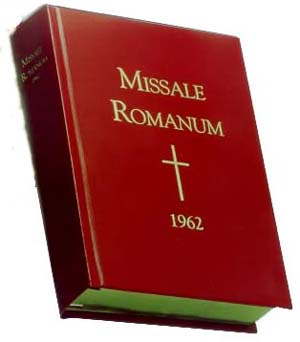
The Roman Missal contains the texts and rubrics for the celebration of the Mass |
Beginning with Quattuor Abhinc Annos (1984) and Ecclesia Dei (1988) of John Paul II, and culminating with the recent motu proprio Summorum Pontificum (2007) of Benedict XVI, in which permission is so graciously granted by the respective Holy Fathers for a Mass that no priest needs anyone’s permission, including the pope’s, to offer any time he so chooses, the authors of these documents specify that these permissions are to celebrate Mass using the 1962 Missal, and only the 1962 Missal. Considering that between those documents, and the letter to the bishops which accompanies the latest motu proprio, this requirement is specified no fewer than 15 times.
“Methinks”, as Shakespeare says through the mouth of Hamlet, “she doth protest too much”. If permission is being given for the use of the liturgy promulgated by the Council of Trent, then why should it matter if the Missal were from 1962 or 1662? The stated reason is that the 1962 Missal was the last “typical edition”, the implication being that it is, therefore, the most “authentic”, as if the Missale Romanum were a sort of encyclopedia, the most reliable edition of which naturally being the one that is most current.
I contend that there is more to this condition than most Catholics suspect, which is a polite way of repeating what I immediately said to myself upon first reading Quattuor Abhinc Annos in 1984: “There‘s something fishy going on here”. When I began to compare the 1962 typical edition with previous editions of the Missale, the nature of the “fish” soon became evident. I will explain as briefly as I am able without doing violence to the subject matter.
First signs of a reform
Doing a comparison of the various editions of the Missale from my own collection, including even one pre-Tridentine edition (1558), the first thing I concluded is that they are substantially identical, save for a few small details (the first post-Tridentine edition of 1570 adds a few rubrical specifications that its predecessors lacked) and for the addition of some feast propers, which is to be expected. This holds true until the typical editions of 1955-56, issued under Pius XII. Beginning in 1955 there were unprecedented changes made to the Missale, the first of many to come. These changes resulted in the Missale of 1962, but culminated in the Missale Romanum of Paul VI in 1969, the Novus Ordo Missae.
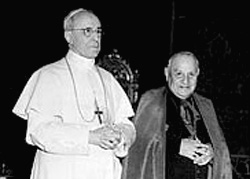
Pope Pius XII with Card. Angelo Roncali, future John XXIII. Bugnini made the liturgical reforms of both Popes |
The changes to the Missal decreed on November 16th, 1955, and becoming obligatory on March 25th, 1956, had their immediate origins several years previous. Shortly after commenting (on the apparitions of Our Lady in Fatima in 1917) “This persistence of Mary about the dangers which menace the Church is a divine warning against the suicide of altering the Faith in Her liturgy…”
This same Pacelli, now Pope Pius XII, established in 1948 the Commission for Liturgical Reform (!), appointing one Fr. Annibale Bugnini as its secretary. Remember that name, for Father, later Archbishop Bugnini, would eventually be revealed as a Freemason and denounced to Paul VI, who immediately removed him from his positions of authority on Vatican commissions and sent him away, eventually to die in exile in Iran. All this, unfortunately, not before he had authored and instigated alteration after alteration of the Church’s liturgy, even finally the Novus Ordo Missae itself.
How the reform of Holy Week in 1955 was made
Shortly after the Commission for Liturgical Reform was founded there came a request from the bishops of France through their spokesperson Cardinal Lienart for permission to restore the Paschal Vigil to the evening rather than its morning celebration. Fair enough. It does seem a bit out-of-place to light a new fire and carry in the triple candle to chants of Lumen Christi in broad daylight. This permission was granted in 1951.
Bugnini and company, though, had only just begun. The magnitude of what came next can hardly be overstated. They went far beyond simply changing the hour of the Paschal Vigil. They had somehow convinced the pope that the whole of Holy Week needed to be restored to a more primitive usage, and so they had basically scrapped the traditional Holy Week (unchanged from the earliest pre-Tridentine Missale I could find, but, more importantly, re-promulgated in the Tridentine Missale of 1570 as well by order of the Council of Trent and Pope Saint Pius V) in favor of what they told Pius XII was the form of Holy Week in use around the time of Saints Wilfred (b. 634) and Bede (b. 672).
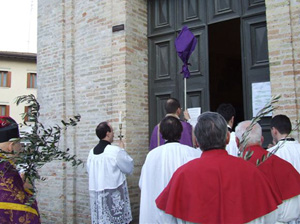
The first changes by Bugnini were introduced in Holy Week ceremonies in 1955 |
Now how the pope accepted this after issuing warnings specifically against this practice of returning to primitive liturgical uses in his encyclical Mediator Dei (1947), and calling those who desired to do so “wicked” in that same document is astounding. Furthermore, the claim that their “restored” Holy Week rites existed at the time of Saints Wilfred and Bede, or at any other time in history seems to have been an utter, complete, and blatant fabrication. They rightly reasoned that neither Pius XII nor anyone else for that matter was capable of verifying the veracity of this claim, and the pope seems to have trusted Bugnini et al implicitly.
Thus in 1955 this fabricated Holy Week was officially promulgated by Pius XII with the document Maxima Redemptionis under the ironic title “The Order of Holy Week Restored”. It is interesting to note that the document Maxima Redemptionis of November 16th, 1955, speaks mainly of restoring the Paschal Vigil to its proper time, with only a footnote at the end mentioning that the ceremonies had been modified a little to restore them to “what was known in the days of St. Wilfred and St. Bede”. Also interesting to note is the fact that, save for some very minor modifications, these new rites of Holy Week “qualified” to be placed into the new Missal of Paul VI virtually intact.
In reality the introduction of new rites was a test to see if anyone would react negatively; whether or not Bugnini and the Commission would be caught in their lies, or whether it would just be accepted on the weight of the enormously popular Pius XII without question. If there were no objections raised, and if the bait were taken, Bugnini knew that there would be little serious opposition to altering the Mass itself.
From there on, one change after another...
In spite of being a glaring violation of Quo Primum of Pope St. Pius V, the bull promulgating the Tridentine Missale as the only acceptable one in the Latin Rite and forbidding the changing of the rites therein, or addition of new rites into said Missale “in perpetuity”, the consequence for doing so being no less than incurring the “wrath of Almighty God and of the Blessed Apostles Peter and Paul, this new Order of Holy Week was everywhere published and accepted without any hesitation whatsoever. The green light had been given to “Brother Buan” (Bugnini’s Masonic codename) to continue implementing their plan of destroying the Faith by destroying the liturgy.
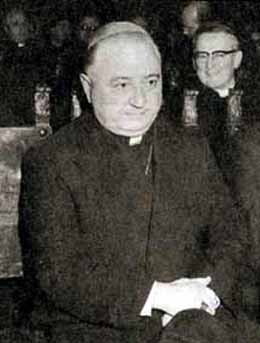
Bugnini continued with the changes after the Council |
From that time one change followed another so quickly that the clergy could scarcely keep abreast of them. As Gertrude says in Hamlet, “One woe doth tread upon another’s heels, so fast they follow”. The additional Collects said at Mass were abolished, along with most of the vigils of feast days. Twelve of fifteen octaves (some dating to the time of Saints Wilfred and Bede!), as well as the proper Last Gospels were also abolished, and so was the Feast of the Solemnity of Saint Joseph, Patron of the Universal Church, this being replaced with the feast of “Saint Joseph the Worker”, a kind of Catholic May Day. All this (and more) in 1955!
1958 saw the resuscitation of the “dialogue Mass” with Pius XII’s “Instruction on Sacred Music”, issued on September 3rd, just one month before his death. One is entitled to imagine that Pius XII was little aware of what was going on at that time as he had been gravely ill for some time.
Though this “dialogue Mass”, in which the congregation makes the responses formerly reserved to the altar boys, and even reciting some parts of the Mass formerly reserved to the priest (!), had been allowed on at least one occasion that we know of, and under duress, by Pope Benedict XV in 1922, it nonetheless represented a significant violation of the traditional practice of the Church and theology of the Mass which holds that the right to make the Mass responses and serve at the altar is technically one enjoyed by clerics alone. Hence altar boys are to wear cassocks and surplices which are clerical dress, to indicate that although lay males could serve Mass when required to do so, this was by way of exception and they are substituting by indult for clerics when such could not be had. One of the obvious implications of allowing all of the faithful, females included, to make those responses traditionally reserved to men in Orders, is that females could, in fact, receive Orders as well, even the Priesthood!
Following the death of Pius XII and the election of John XXIII in 1958, the changes continued unabated. In 1960 Pope John named Fr. Bugnini secretary of the Preparatory Liturgical Commission for the upcoming council that he had invoked. From then until 1962 more feasts were abolished, the unchangeable Canon of the Mass (the word “canon” means “unchangeable”), was changed by the insertion of the name of St. Joseph, as if to redress some oversight committed by the early Church, which apparently had insufficient devotion to St. Joseph as they failed to place his name in the Canon. Other rubrical changes were made as well, including the elimination of the Confiteor prior to the reception of Holy Communion by the Faithful during Mass. These changes had the effect of numbing the sensibilities of Catholics, clergy and laity alike, and to habituate them to the novel idea that nothing was exempt from change. They were, of course, designed to pave the way for the eventual introduction and acceptance of the Novus Ordo Missae.
One example of those baseless changes, the abolition of the Confiteor
Just as one example, let us consider the already-mentioned elimination of the 2nd Confiteor, as it is commonly referred to. This was done with the excuse that the Confiteor had already been said at the beginning of Mass, so to recite it again in the middle of Mass would qualify as a “useless repetition”. Not so, however. You see, the Communion of the Faithful is neither necessary, nor, properly speaking, a part of the Mass at all. When there are faithful who are to communicate at a Mass, this is accomplished by the insertion of a Communion rite, if you will, into the Mass, similar to that which one would use when bringing Holy Communion to the sick. This rite of receiving Holy Communion necessarily begins with a Confiteor. Such is the proper order of things. The priest doesn’t just go in and jump straight to giving the person or people the Eucharist without some sort of penitential rite preceding it.
The recitation of the Confiteor during the Prayers at the Foot of the Altar is only for the priest and the other sacred ministers, or altar boys as the case may be. To eliminate the “2nd Confiteor” would imply either that the faithful had no need of it, or that the Communion of the faithful were actually a part of Mass rather than being what it is, something outside of Mass but done within the context of Mass, as are the readings in the vernacular and the sermon. There were other changes made during this period, but I believe that these examples suffice to illustrate my point.
The right not to accept the 1962 Missal
In conclusion I wish to note that, with the possible exception of the new rites of Holy Week, none of these changes are heretical or contrary to the powers of the papacy to accomplish. Pius XII and John XXIII undoubtedly possessed the juridical, if not the moral, right to make them. This being so, would it not, then, be an act of disobedience to reject the 1962 Missale for the celebration of the traditional Latin Mass as its advocates claim? I claim that not only is it not an act of disobedience to reject this Missal and, indeed, every version of the Missale going back to when the new rite of Holy Week was first introduced into it, but that it is, in fact, what reason would dictate that one must do if one is indeed serious about returning to and/or upholding the liturgical tradition of the Church.
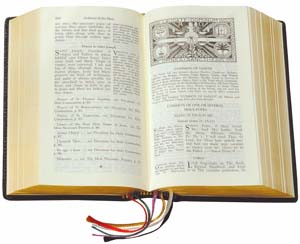
A 1962 Roman Catholic Missal compiled from the Missale Romanum for the use of the faithful |
Look at it this way: All of these changes were masterminded by Annibale Bugnini, a proven Freemason, whose intention as a member of that secret society planted within the very highest echelons of the Vatican was to do as much damage as possible to the Church, Her Faith, and the faith of Her members. Although he would accomplish this most effectively later on with the advent of the Novus Ordo Missae, the changes already introduced into the 1962 Missale were nonetheless intended for that same purpose. The 1962 Missale is corrupted, and substantially discordant with the Missale Romanum as promulgated in fulfillment of the commands of the Council of Trent by Pope Saint Pius V. Neither can the claim that none of these changes is heretical in content be used as an argument in favor of its use, for neither is the employment of hula girls, fireworks, and mariachis strictly speaking heretical in itself, but they belong to that class of novel and profane things that do not belong in the Mass.
I might add that the fact that the 1962 Missale was either accepted and/or used by one or another prelate or priest who were in themselves good men of virtue does not excuse its use now in light of the facts I have just presented.
When it comes down to it, if one can justify the use of the 1962 Missal to oneself in spite of all this, then one has no good and valid reason left to proffer for not accepting and using the Missale Romanum of Paul VI, which, it is claimed, likewise contains no specific heresy (since the original introduction, which did in fact contain an heretical definition of the Mass, was corrected), and was introduced by a validly reigning pope.
This, I believe, is the reasoning behind the recent Roman documents insisting on the use of the 1962 Missale and no other. Celebration of the immemorial Liturgy of Rome as codified by the Council of Trent ought properly to be done using an edition of the Missale which does not vary substantially from that codified on the orders of that same council. The Missale Romanum of 1962 contains not only changes, but important and substantial ones which violate the injunctions of Quo Primum and the whole of the Church’s liturgical tradition.
One further difficulty is presented by the fact that at the time of the writing of this article, nobody has had the funding, or perhaps even the interest, to reprint an editon of the Missale which antedates the inclusion of these changes. Reproductions of the 1962 version are, on the other hand, relatively cheap and plentiful. Should this plea reach a benefactor with the means to undertake the costly task of reprinting one of the later but incorrupt editions, I would gladly offer one of my older Missals, some of which are still in the box, for the project.

Posted September 11, 2007

Related Topics of Interest
 Quo Primum vs Novus Ordo Mass Quo Primum vs Novus Ordo Mass
 The Motu Proprio, after the Emotions The Motu Proprio, after the Emotions
 The Six Marks of the Novus Ordo Mass The Six Marks of the Novus Ordo Mass
 The Cheese in the Mousetrap The Cheese in the Mousetrap
 Lifting the Ban on the Tridentine Mass Lifting the Ban on the Tridentine Mass
 The Abomination of Desolation in Machabees and in the Present The Abomination of Desolation in Machabees and in the Present
 Pan-Religious Ceremony at St. Peter's Basilica Pan-Religious Ceremony at St. Peter's Basilica
 Crisis in Catechism Crisis in Catechism
 The New Mass: A Flavor of Protestantism The New Mass: A Flavor of Protestantism
 Liberalism, Modernism and Progressivism Liberalism, Modernism and Progressivism

Related Works of Interest
|
Traditionalism | Hot Topics | Home | Books | CDs | Search | Contact Us | Donate

© 2002- Tradition in Action, Inc. All Rights
Reserved
|
 |
|